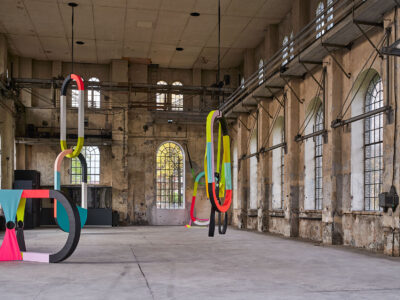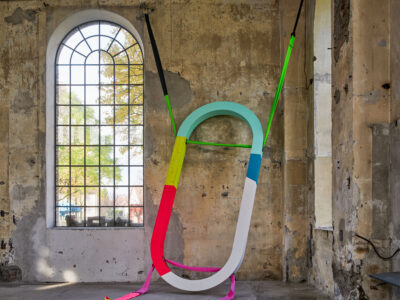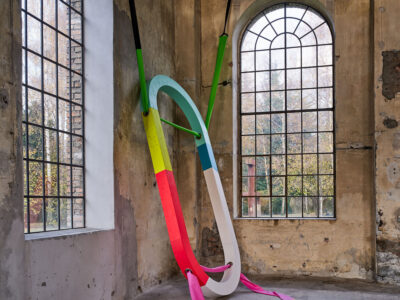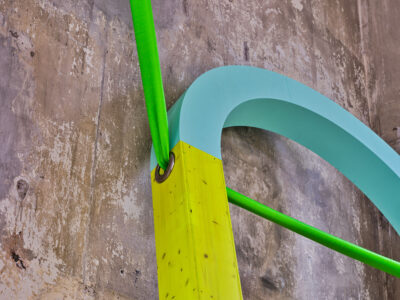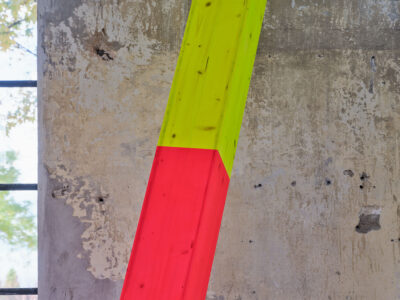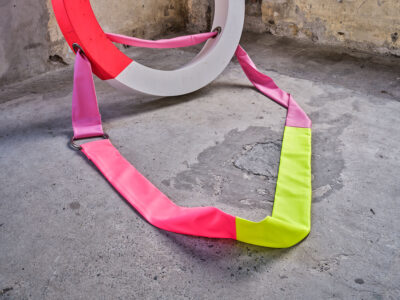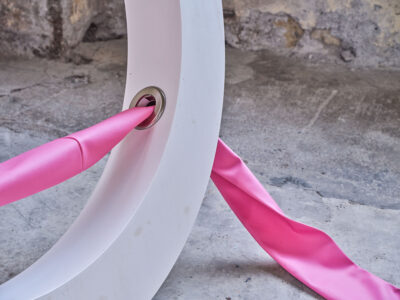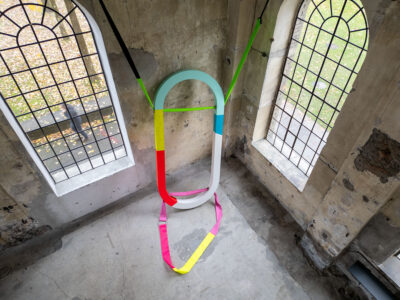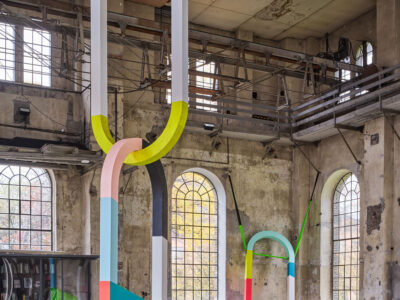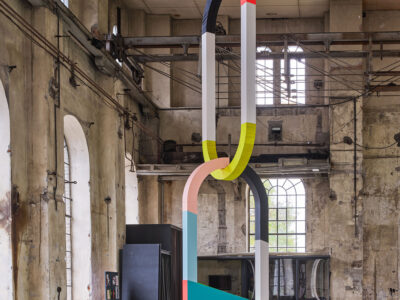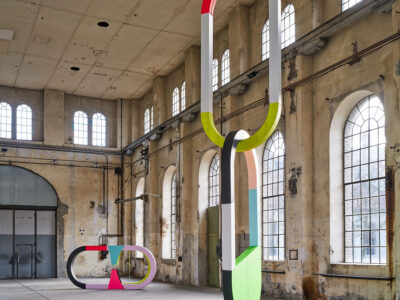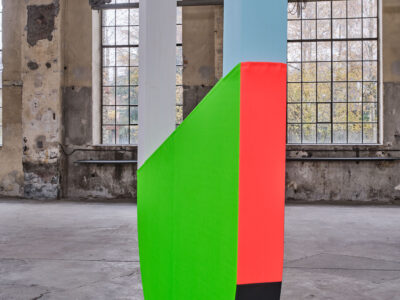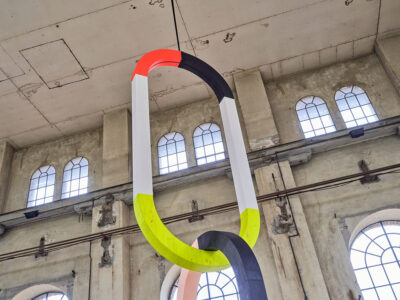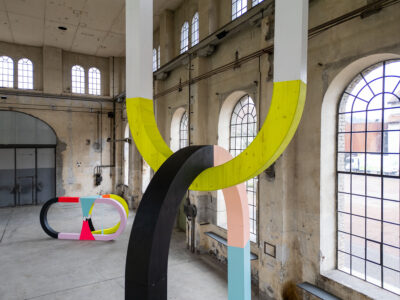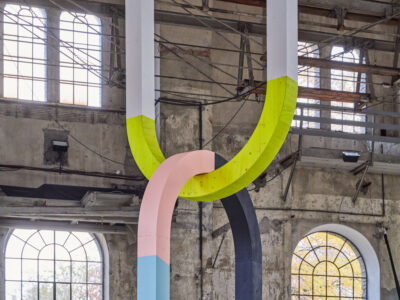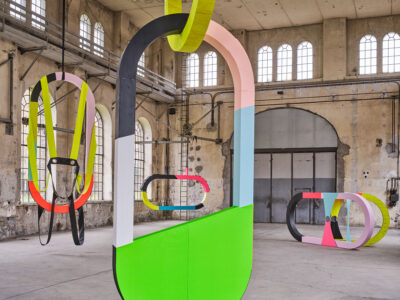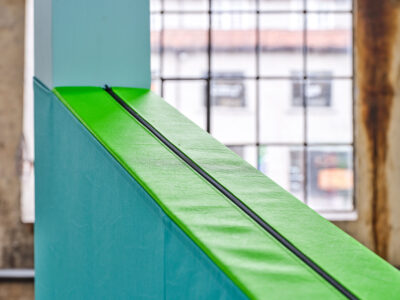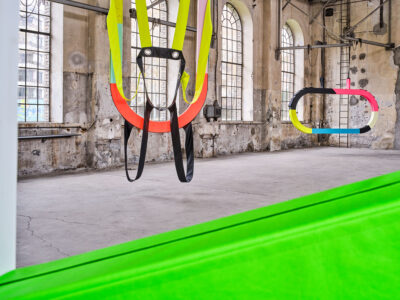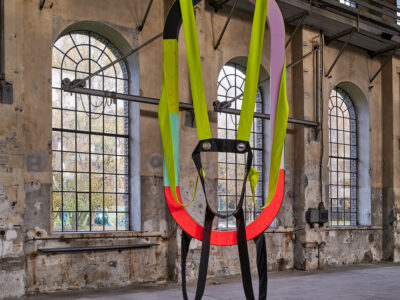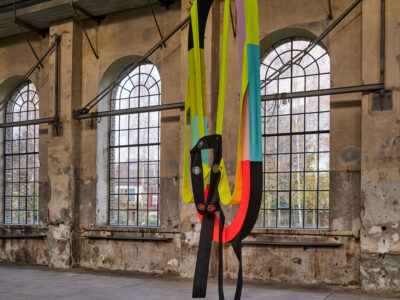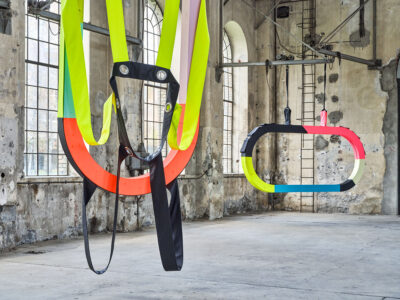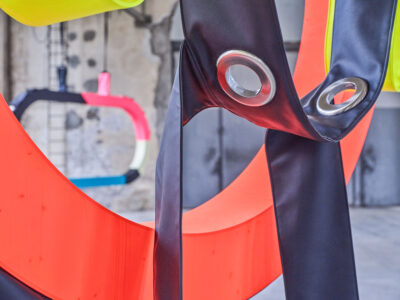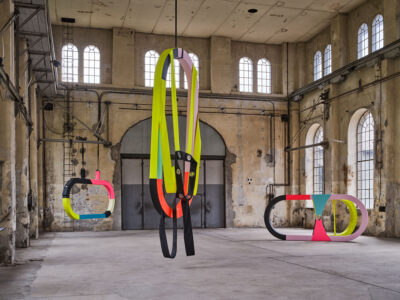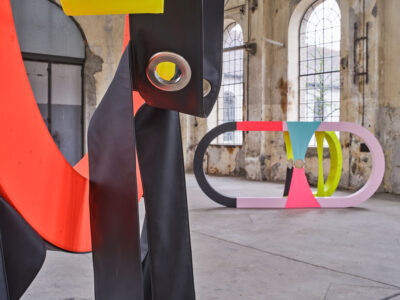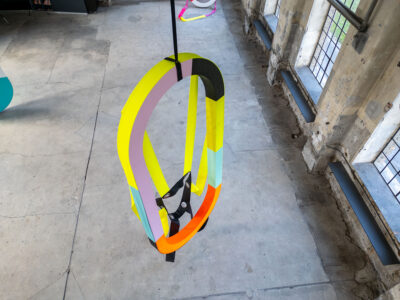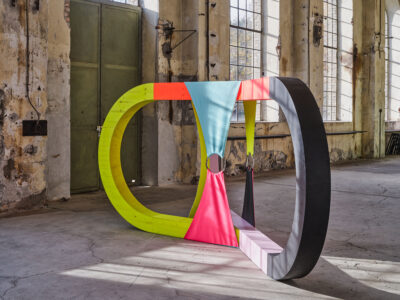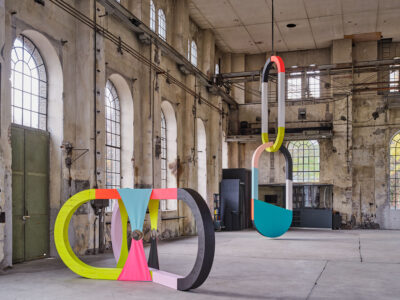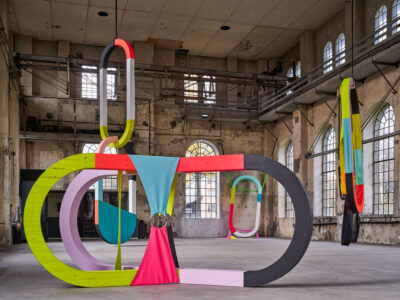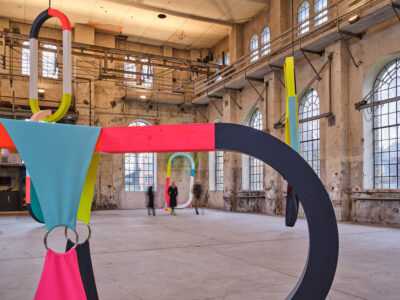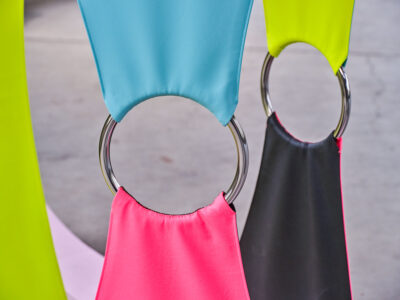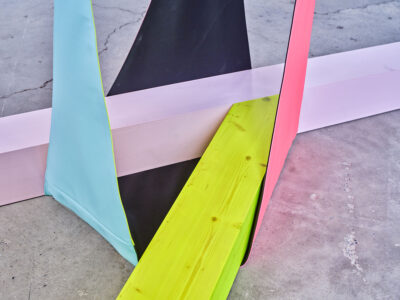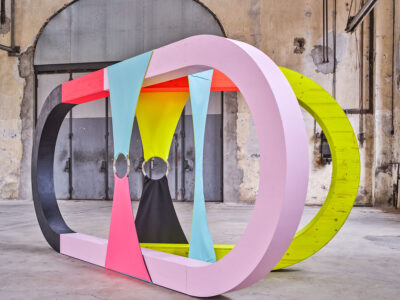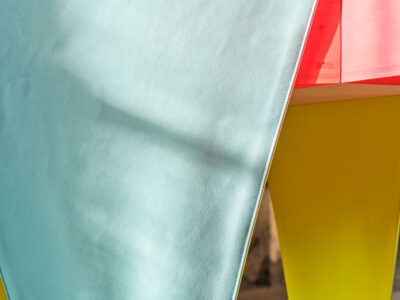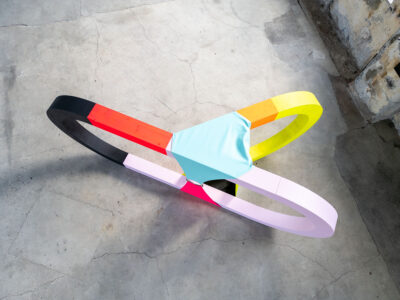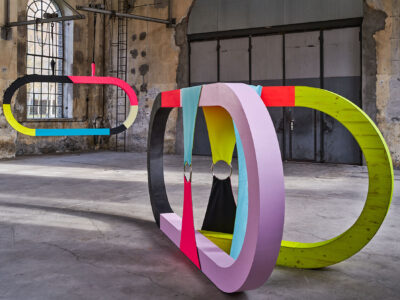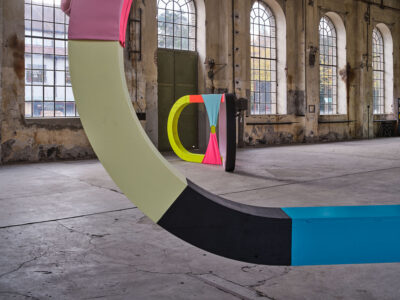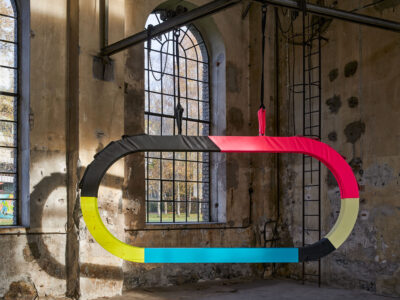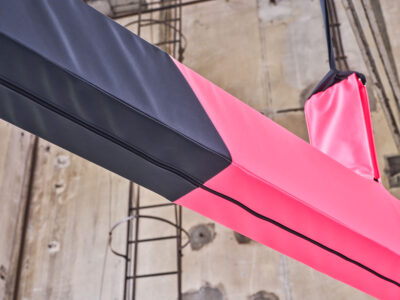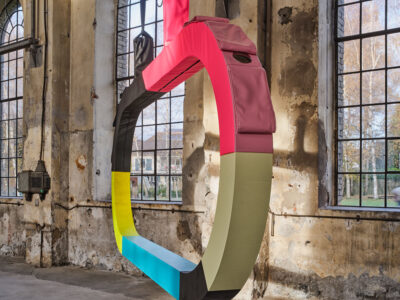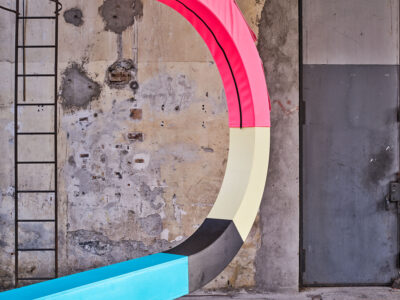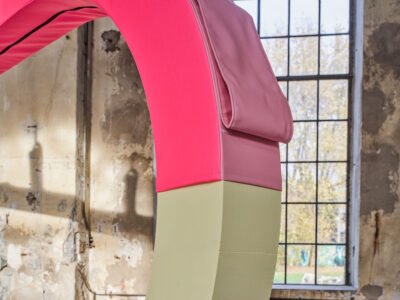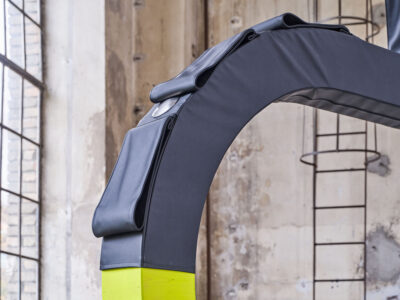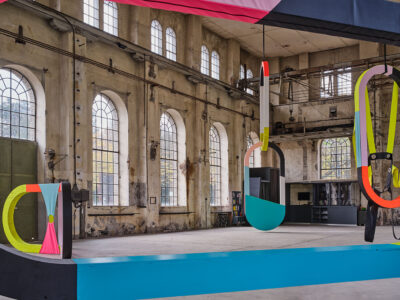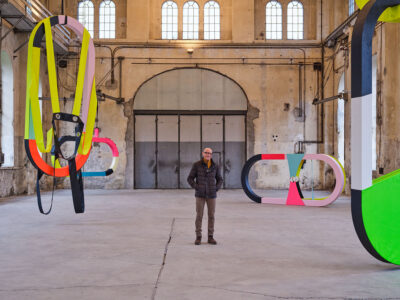Artist Statement / Konzept zur Ausstellung „blingbling“
im Kunstraum Dornbirn, November 2023 bis Februar 2024
Der Kunstraum Dornbirn – ehemals eine Montagehalle einer Maschinenfabrik – wird Schauplatz einer Inszenierung, die ihren Architekturbezug sofort offenlegt: sowohl Form, Proportion als auch Größe der ausgestellten Objekte leiten sich direkt von den Fenstern ab. Lediglich ihre geschlossene elliptische Form unterscheidet sie.
Sie erscheinen als isolierte Raum-Körper, die den Bezug zu ihren Fenster-Protagonisten, die den beinah sakral anmutenden Hallen-Raum rhythmisch und klar gliedern, leicht ausspielen.
Rahmen, die den Blick bündeln und lenken, zu anderen Rahmen, oder hinaus, durch die Fenster. Perspektivenwechsel eröffnen sich, Blickachsen wechseln – diese räumliche Dynamik der gehängten und gestellten Objekte spiegelt das starre Korsett der Fenster- Reihung wider.
Der „rohe Zustand“ in dem die Montagehalle belassen wurde, ist nicht nur Kulisse – die ursprüngliche Funktion des Raumes wird beansprucht, da noch vorhandene Aufhängesysteme genutzt werden. Von der Decke hängen überdimensionale Dinge, baumeln Kettenglieder, die sich am Boden ineinander schieben, wird ein Ring an zwei Halbsäulen verspannt – die Ausstellungshalle mit ihren offengelegten Konstruktions- und Leitungssystemen bietet die Möglichkeiten, die diese bruchstückhafte Inszenierung dramatisch erscheinen läßt.
Die mit Acrylfarbe zum Teil lasierend, meist deckend durchgemalten Holzkörper bekommen mehr Plastizität durch applizierte Kunstledermembrane, verspannte Kunstledergurte, -schlaufen. Diese Lederelemente werden mit Metallnieten am Holz fixiert, beziehungsweise ähnlich dem Piercing wird Leder und Holz durchstanzt, mit einer Metallöse bewehrt, präpariert für eine gewünschte Hängung.
Kunstleder, Nieten, Ösen, vermeintliche Versatzstücke einer Fetish-Mode-Szene werden auf einer abstrakten Ebene zu Gestaltungselementen, bleiben aber durchlässig für unterschiedliche Vorstellungsebenen: überdimensional, im Raum exponiert, verliert der Körperbezug an Intimität. Monströs, absurd lösen sich Phantasmen in einer bunten Leichtigkeit auf.
Gabriele Fulterer & Christine Scherrer, 2023
Fotos und Video: Günther Richard Wett
Art Director Thomas Häusle in talk with the Artists
Your artistic training is quite different, but overlaps in the discipline of sculpture. What was before Fulterer Scherrer?
There was Gabriele Fulterer solo (sculpture, drawing) and Christine Scherrer solo (figurative painting, tapestry). As part of a jointly curated exhibition in which our works were reinterpreted and staged, a co-operative work, a wall drawing, was created. We enjoyed the collaboration so much that we decided to expand our concept and include several co-productions in future shows. In 2007 we decided to get started as an artist duo with new focal points in content and form.
You have been working as the artist duo “Fulterer Scherrer” since 2007. How did this collaboration come about and how does it work in terms of content in your artistic practice?
Initially, our focus was on expressive figurative drawing, which was staged in various ways – as oversized wall paintings (“My Mom”, AllerArt, Bludenz 2012), embroidery work in combination with wall paintings (“As if”, Christine König Galerie, Vienna 2013; “Hand & I”, Dorsky Gallery New York 2019; “#Actin#No”, Galerie Lisi Hämmerle, Bregenz 2015) and installative drawing/ painting in public space (Fluc, Vienna 2008; Cityspace 7, Vienna 2013).
Because of our very broad artistic training (classical sculpture, textile art, painting and conceptual art), new interests and priorities arose over time. We’re currently working in the area of abstract constructive painting that interacts with fashion, fetish and design. But there was also a series (“Within circles”) in which we explored the boundaries between abstract, expressive painting and figurative drawing anew using the medium of classical painting. It’s extremely important for us to be responsive to current social, political and artistic tendencies – to constantly reposition ourselves.
Who or what particularly shaped and influenced your artistic development?
We define ourselves as feminist artists and in this light there have been primarily women artists whom we both admire and whose work has certainly influenced us indirectly. Since our way of working can certainly be described as “crossover”, our personal icons can be found in all artistic disciplines: we loved, love and admire Louis Bourgeois, Tracy Emin, Dorothea Tanning, Valie Export, Artemisia Gentileschi, Mary Cassat, Nancy Spero, Agnes Varda, Ingeborg Bachmann, Anette Messager, Chantal Ackermann, Cindy Sherman, Jenny Holzer, Guerrilla Girls… in the different phases of our personal and artistic development.
You boldly and joyfully juggle different techniques, disciplines, materials and topics, combining, linking and intertwining the elements. How do you describe your artistic practice and technique?
We are maximally flexible in terms of both the content and the technical execution of our work because we are always interested in new things. Since we also enjoy the privilege of sound artistic training, both in terms of content and technique, the implementation of new works never crashes due to restrictions of any kind.
A recurring question concerns the mode of our collaboration – in short, “who does what?” – and here it would be wrong to orient the answer with respect to our artistic training. We work in a very procedural way; steps such as brainstorming, drawing, painting, object design are always carried out alternately by one of us and handed over to the other for assessment and further development. The work is created step by step; one of us can criticize and/or reject the efforts of the other, but must never influence the other. Ideally, we both agree with one another’s results and the work works.
Your art transcends and ignores, or rather plays with interfaces between art, design and craft, mixing consumer, mass and high culture. You masterfully understand how to free issues such as sexuality, power or identity from their heaviness, but not from their significance. How do you achieve this effect?
Sexuality, power and identity are topics that actually affect everyone directly. The term “heaviness” is very poetic, but also sad in this context. Finding your own sexuality and identity should always be a thrilling, exciting and cool thing, but unfortunately that is still not always the case today. For us, art can “work” in a positive sense, especially in this area, by “opening up”, “showing perspectives”, “stimulating” without appearing directly didactic. To suggest things but not explicitly address them, to transcend genres without judging, to understand givens as not fixed, to loosen them from their anchorings – to offer a production that allows everyone to approach diverse content in a relaxed manner.
The exhibition at Kunstraum Dornbirn is entitled “blingbling”. Your titles are usually chosen very carefully, are part of the works and often provide a guide to interpreting and understanding them. How should we understand “blingbling”?
As our individual works are always listed as “Untitled”, we attach great importance to the titles of series of works and shows. The goal is always to find a short, pithy title that makes you want to view the work and evokes a broad field of associations.
For this exhibition, our starting and reference point was Kunstraum Dornbirn’s windows, which expand the industrial charm of the building to a sacral level. Our new interpretations of the windows could on the one hand be seen as windows, but also on the other hand as chain links. From these supersize chains to the hip-hop chains of the 90s was a small step; in the urban dictionary of hip-hop, rappers’ oversized necklaces are referred to simply as “blingbling”. “Blingbling” can mean anything and nothing; we liked mainstream associations like “supersize, jewellery, glamour, fashion, hardcore, fetish” right away; and terms like “flashy, flamboyant, ostentatious, expensive” could also describe our objects at Kunstraum.
The works at Kunstraum present a remarkable development of your previous series “studs”. They no longer appear to be of manageable dimensions, but rather almost threateningly large. What development do you see in these huge new works and what role did the historic assembly hall of Kunstraum Dornbirn play in it?
It was clear to us right off that we wanted to focus not only on the spatial constants, but also on the special atmosphere of Kunstraum. There is the clear formal reference to the windows – detached from the wall construction, they don’t displace, claim or occupy any space, but rather dynamise it inwardly; the structure of the static spatial construction begins to move. The supposedly dark atmosphere of the hall offers a strong contrast to the bright, loud colours of the objects: an abandoned, sombre place that now interacts with neon and glamour. A reference to content is created in that the existing cranes are reactivated in their former function as assembly elements. In terms of development, the work was of course initially a challenge – the size of the objects in the “studs” series are 50 x 70cm – but basically we like to work on installations and on a large scale, previously only with wall works, but now also with objects. In this respect, “blingbling” has taken us one step further towards large-format objects.
The artificial leather covered with lacings, belts, studs and eyelets and loud in bright colours: what subcultures, fashions and identities, their struggles, problems and raison d’être are important to you, and to what extent do they determine your artistic language?
Fashions and identities change of course all the time, and we certainly have different starting points in our social origins, education and cultural backgrounds. The affinity for fashion, good design, architecture, literature and club culture was certainly a meeting point in our case. In her student days, Gabriele could be clearly defined as a punk – here perhaps is where our predilection for studs and eyelets comes from. Christine wavered a long time between taking a degree in art or in fashion. Fortunately, moving in various scenes wasn’t and isn’t a real problem for our generation. So we move and moved both in our artistic lives – between object/painting/drawing/ figurative/abstract/expressive/constructive – and in our personal lives – in straight/queer/ whatever spaces. In this sense, the question about the direct influences of subcultures has no direct answer: our art certainly changes in response to new trends in the art scene, just as we certainly also respond consciously or unconsciously to fashion, design and social trends that are relevant to us.
Your artistic work is often about identity, gender issues, sexuality, questions about power, social development and subcultural attributions. In spite of the complexity of content and topics, the works seem immediately understandable, never accusatory or reproachful, almost friendly and congenial. How does this work in relation to “blingbling” and beyond?
Accusation, reproachfulness, is very far from our minds. We prefer the absurd, skewed and funny. This offers us freedom in form and content – an ease with which we can approach topics without diminishing their explosive force and significance.
Through your choice of colours and materials, you combine the harmonious and the opposing, the abstract and the representational. What does this “both/and” mean to you?
An exciting question, which occupies us throughout the entire work process. Elements seem to be located in the representational – fragments perceived to come from fashion/fetish. In the work these meet purely abstract constructions. What we’re interested in here isn’t a with-one- another or an against-one-another, not assertion, adoption or recoding; we’re interested in the ambivalences, the loss of clear positioning, the abandonment of valid boundaries. A lot of things seem to dissolve, only to reappear in the next moment.
With the project in Dornbirn, your previous work hasn’t only been expanded, but also developed significantly. Where will Fulterer Scherrer’s artistic journey go in the near future?
In the near future we plan to stay in the area of objects, probably no longer on this huge scale, but still significantly larger than before. There are already ideas for these new objects, but as we’re both perfectionists, we’ll definitely invest more time in their development. The fixed points for next year are the realisation of two art-in-architecture projects: a new installation work from the “Bondage” series at the St. Gallen Cantonal Hospital and a conceptual spatial installation wall design at the Rankweil State Hospital.
